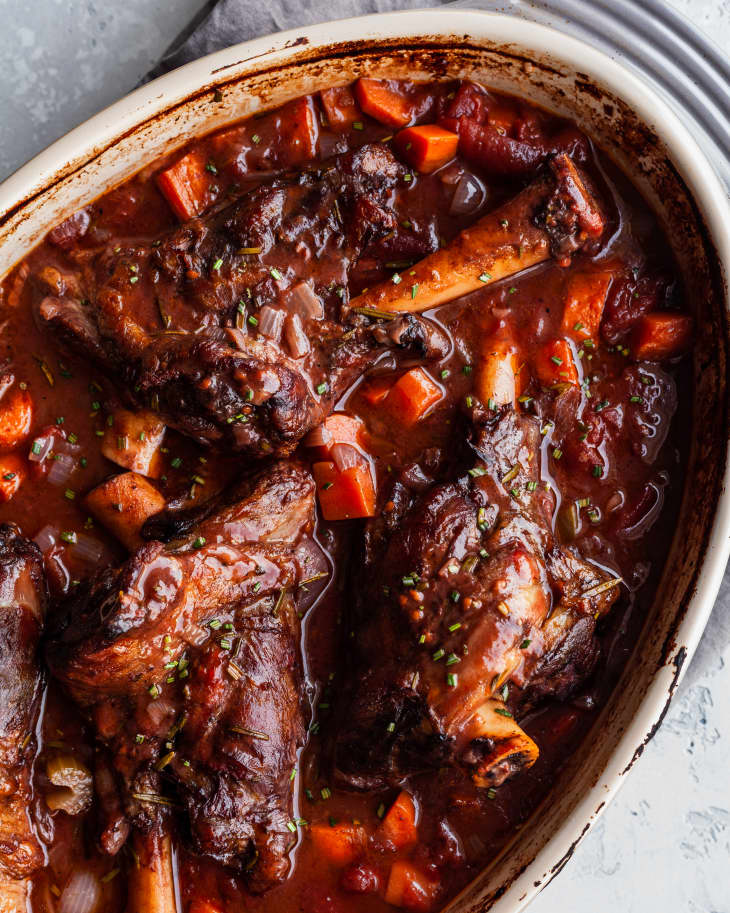What Exactly Is Braising? Here’s Everything You Should Know
You’ve probably come across the word “braised” a few times as you’re looking for recipes to cook. Think: braised beef in red wine, Chairman Mao’s red-braised pork belly, mustard and wine-braised chicken, green curry braised salmon, or braised shiitake mushrooms.
What Is Braising?
Braising is a cooking method that consists of searing meat, such as beef or lamb, quickly on high-heat and then following it with a low and gentle simmer in a layer of liquid.
A truly magical transformative process, braising helps enhance the flavor of any dish and creates fall-off-the-fork tenderness. It’s also a convenient way of making one-pot meals. If you’re curious to master this technique, we’ve got you covered from diving into this cooking method to braising meat and vegetables like a pro.
Braising 101
Simply put, braising is a cooking method that involves a quick, high-heat sear followed by a low and gentle simmer in a thin layer of liquid. This marriage of opposites allows the star ingredient to shine, producing a succulent, juicy meat or vegetable that’s steeped in flavor.
There are steps on braising meat or vegetables (more on that below), but generally speaking, the main protein is browned and slow-cooked on a bed of vegetables, mirepoix, with a small amount of liquid in a tightly sealed pot, like a Dutch oven, for a couple hours on a low heat.
Why Do We Braise?
The challenge of cooking meat is that sometimes, it can turn tough and dry. And when that happens, moisture is lost and flavors are being stripped away. This is where braising comes in, as it helps minimize moisture loss and compacting of the meat fibers, while maximizing the conversion of tough collagen to fluid gelatin, as written in the book On Food and Cooking: The Science and Lore of the Kitchen by Harold McGee.
How Does Braising Tenderize Meat?
First, let’s understand what collagen and gelatin are. Collagen is an elastic connective tissue that can be found in all muscles of an animal. It works as a structure and supports surrounding animal’s muscle fibers.
When braising tough cuts of meat high in collagen — such as lamb shank, oxtail, brisket, short ribs, or pork shoulder — in liquid for a prolonged period, the collagen breaks down into gelatin, a protein that subsequently thickens the braising liquid, giving it a rich texture and concentrated flavors.
Since gelatin is able to absorb up to 10 times its weight in water, according to ScienceDirect, the moisture that is repelled by the protein is absorbed by the gelatin and so the meat stays moist.
The Difference Between Braising and Stewing
When you see recipes that require braising, try not to confuse it with stewing. Braising involves cooking large pieces of meat or vegetables partially covered in liquid, while stewing uses smaller pieces of meat totally immersed in liquid, which can be a combination of stock and water.
How to Braise Meat or Vegetables
You can braise tough cuts of meat or vegetables like cabbage and artichokes. By following these steps, you’re not only getting it right, saving you time, but also making use of the ingredients. To get it right the first time, here are the steps on braising meat.
- Sear the meat or vegetables you like to braise. In a Dutch oven set over medium-high heat, drizzle a little fat, such as olive oil or butter, and coat the bottom of the pan, then sear each side of the seasoned meat until golden brown. The meat will develop a deep, golden crust, while the sugar in vegetables caramelizes. Remove from the pan, and set aside.
- Add your aromatics. Sauté aromatics, such as garlic, onions, and shallots, and cook it with the drippings.
- Deglaze pan with any form of liquid. Add stock, wine, beer, or even water into the pot. Your choice of liquid will depend on what is being cooked. The liquid will help loosen and dissolve the rich, savory bits, aka the “fond” in French cuisine. Scrape all those brown bits and stir into the braising liquid.
- Bring liquid to a simmer. Bring your star ingredient back into the pan, and make sure the meat is partly submerged.
- Cover the pot and continue to cook in the oven or on the stove. When cooking vegetables, shorten the cooking time since vegetables tend to be more delicate and you want to avoid turning them into mush.
History of Braising
Back before modern stoves, cast iron pots with tight-fitting, flat lids were used — as explained in this video. During the Middle Age, the French would use coal to cook food, and they would put it on the lid of the pot as well. Applying heat from all sides ensured the food was cooked uniformly.
In French, “braise” means “live coals”, and the term “braising” originates from the French verb “braiser”, meaning to cook over live coals. When you braise food, you’re not literally cooking over coals, but you are aiming for a combination of moist-heat and dry-heat cooking.
Types of Braising
Braising comes in two types: “brown braising” and “white braising”, and their difference boils down to browning the ingredients.
In brown braising, the meat is seared in a pan until it turns brown — hence the name, and then placed in a pot. Cooking the meat beforehand concentrates the meat juices that will be released during the braising. When a recipe calls for vegetables to be brown braised, it means they are browned before any type of liquid is added.
White braising, meanwhile, doesn’t brown the ingredients. The meat is also cooked in a pan, but not to the point it becomes brown.
